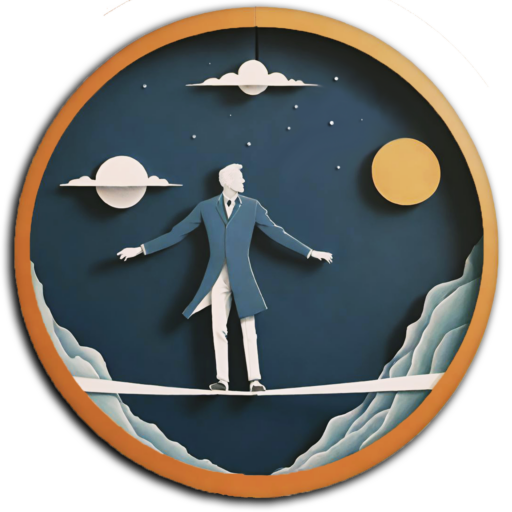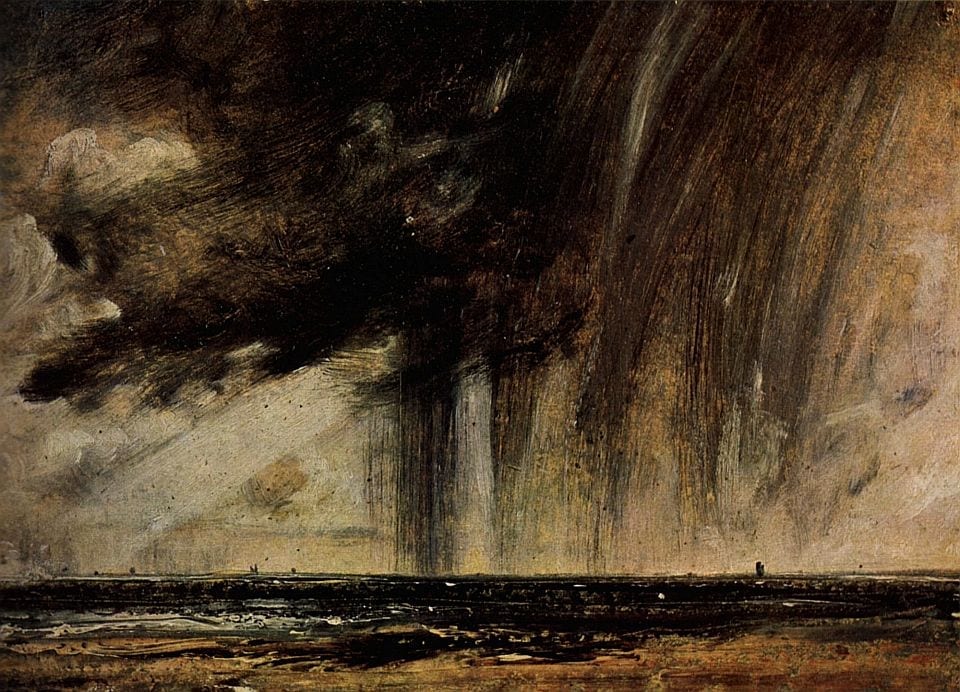–
[ezcol_1half]–
meditación sobre john constable
–
–
«La pintura es una ciencia, y debe hacerse
como una investigación de las leyes de la naturaleza.
¿por qué, entonces, la pintura de un paisaje no puede
ser considerada una rama de la filosofía natural,
de la cual, los cuadros son sólo los experimentos?»
–
-John Constable: La Historia de la Pintura del Paisaje
–
Él mismo respondió a su pregunta, y con la natural
exactitud del arte; enriqueció sus premisas
al confirmar su práctica: la labor de la observación
frente al hecho meteorológico. Las nubes,
unas seguidas de otras, templan el sol cuando pasan
y se alejan. Al volver a ocultarlo las tinieblas
concentradas, surgen de ellas rayos suaves
que se esparcen apagados, hasta que el foco
se descubre e inunda con fuego intenso
las nubes que se marchan. Se perciben (aunque escasamente)
las nubes restantes que lo cruzan rezagadas,
hechas jirones y disueltas en bruma.
Pero las siguientes lo van a contener. Pasan amenazantes
y merman su fulgor, quedando reducido a una franja de luz
que es cubierta del todo, a un destello que aún se alarga
mientras la masa se adensa, aunque no pueden excluir
su amarillo plateado. El eclipse es repentino;
se observa primero cómo la hierba se oscurece, y luego
se completa cubriendo todo el cielo
Los hechos. ¿Y qué son?
Él admiraba los accidentes, porque eran gobernados por leyes,
y los representaba (puesto que la ilusión no era su fin)
gobernados por el sentimiento. El fin es nuestra aquiescencia
libremente acordada, la ilusión que nos persuade
de que existe como imagen humana. Atrapada
por un sol vacilante o bajo un viento
que al humedecerse entre las siluetas de la fronda
se dispone a disolverlas, tiene que hacerse constante;
aunque allí, agitándose separados, los inquietos
árboles dejan pasar la distancia, como niebla blanca
que ocupa sus hileras rotas. Debe persuadir
y con constancia, para que no vuelva a disiparse
y revele lo que medio esconde. El arte es él mismo
cuando lo aceptamos. El día cambia. Él lo habría juzgado
exactamente con esa misma claridad, que franquea
las manchas intensas de las sombras que las nubes proyectan,
ahora suprimidas, mediante su explosión de color.
¿Un pintor descriptivo? Si el gozo
describe, lo cual extrae del pincel
los errores de un espíritu, ya así mitigado,
puede renunciar a todo patetismo; pues lo que él vio
descubrió lo que él era, y la mano —firme
ante el dictado de un solo sentido—
encarnó el exacto y total conocimiento
en una caligrafía de placer presente. El arte
es completo cuando es humano. Es humano
si los pigmentos entrelazados, los puntitos de luz
que aseguran el espacio bajo sus hábiles restricciones
convencen, al ser indicado de una posible pasión
como indicador adecuado a la vez de la pasión
y de su objeto. El artista miente
para beneficio de la verdad. Creedle.
[/ezcol_1half] [ezcol_1half_end]
–
–
A Meditation On John Constable
–
«Painting is a science, and should be pursued
as an inquiry into the laws of nature.
why, then, may not landscape painting
be considered as a branch of natural philosophy,
of which pictures are but the experiments?»
–
––John Constable: The History of Landscape Painting
–
He replied to his own question, and with the unmannered
Exactness of art; enriched his premises
By confirming his practice: the labour of observation
In face of meteorological fact. Clouds
Followed by others, temper the sun in passing
Over and off it. Massed darks
Blotting it back, scattered and mellowed shafts
Break damply out of them, until the source
Unmasks, floods its retreating bank
With raw fire. One perceives (though scarcely)
The remnant clouds trailing across it
In rags, and thinned to a gauze.
But the next will dam it. They loom past
And narrow its blaze. It shrinks to a crescent
Crushed out, a still lengthening ooze
As the mass thickens, though cannot exclude
Its silvered-yellow. The eclipse is sudden,
Seen first on the darkening grass, then complete
In a covered sky.
Facts. And what are they?
He admired accidents, because governed by laws,
Representing them (since the illusion was not his end)
As governed by feeling. The end is our approval
Freely accorded, the illusion persuading us
That it exists as a human image. Caught
By a wavering sun, or under a wind
Which moistening among the outlines of banked foliage
Prepares to dissolve them, it must grow constant;
Though there, ruffling and parted, the disturbed
Trees let through the distance, like white fog
Into their broken ranks, It must persuade
And with a constancy, not to be swept back
To reveal what it half-conceals. Art is itself
Once we accept it. The day veers. He would have judged
Exactly in such a light, that strides down
Over the quick stains of cloud-shadows
Expunged now, by its conflagration of colour.
A descriptive painter? If delight
Describes, which wrings from the brush
The errors of a mind, so tempered
It can forgo all pathos; for what he saw
Discovered what he was, and the hand––unswayed
By the dictation of a single sense–
Bodied the accurate and total knowledge
In a calligraphy of present pleasure. Art
Is complete when it is human. It is human
Once the looped pigments, the pin-heads of light
Securing space under their deft restrictions
Convince, as the index of a possible passion,
As the adequate gauge, both of the passion
And its object. The artist lies
For the improvement of truth. Believe him.
[/ezcol_1half_end]
–
Charles Tomlinson
–
Meditación sobre John Constable
Meditation on John Constable
inwardboundpoetry.blogspot.com.es
–



0 comentarios